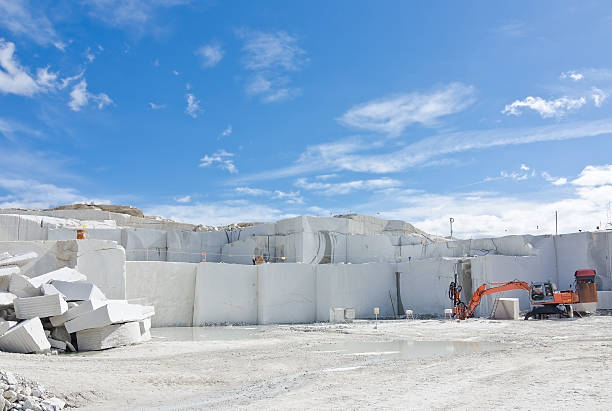The Hidden Gems: Discovering Granite Quarries in South Africa
The Hidden Gems: Discovering Granite Quarries in South Africa
Blog Article
Discovering the Rich Background and Sustainable Practices of Granite Quarrying
As we depend on the precipice of revealing the detailed tapestry of granite quarrying, a trip with time reveals not simply the physical act of drawing out stone yet additionally the cultural and historical relevance woven right into the extremely fabric of this technique. From the old origins that laid the foundation for contemporary quarrying strategies to the lasting practices that are forming the future of this industry, each chisel mark on granite surfaces tells a story waiting to be unearthed (granite quarries in south africa). The tradition of granite quarrying extends far past plain removal; it is a testimony to human ingenuity, resilience, and the long-lasting appeal of this stunning rock
Old Origins of Granite Quarrying
Dating back to ancient civilizations, the method of quarrying granite has been an indispensable part of human history and building improvement. The earliest evidence of granite quarrying dates back to ancient Egypt, where large pyramids and elaborate sculptures were crafted from this sturdy rock. The Egyptians made use of primitive tools to extract granite blocks from quarries, showcasing the significance of this material in their significant constructions.
Moving on in history, the Greeks additionally made significant contributions to the quarrying of granite. The Greeks utilized granite in different architectural marvels, such as temples and sculptures, showing their ability in shaping and carving this durable rock. The Romans even more fine-tuned the methods of quarrying granite, using advanced devices like knives and hammers to remove and form granite for their renowned frameworks.
With the centuries, the technique of quarrying granite has actually progressed, with contemporary innovations improving effectiveness while keeping the ageless allure of this natural rock - granite quarries in south africa. From ancient people to modern building contractors, the heritage of granite quarrying remains to form our globe
Development of Quarrying Techniques
The advancement of quarrying methods has actually been marked by a constant progression in the direction of greater effectiveness and precision in drawing out granite. From the primary methods utilized by our forefathers to the innovative technologies made use of in modern-day quarrying operations, the market has undergone significant innovations. Early quarrying techniques entailed manual work with fundamental tools such as knives, hammers, and wedges to remove granite blocks from the planet. As civilizations proceeded, methods like fire-setting and primitive nitroglycerins were introduced to facilitate the extraction procedure.
In even more current times, the development of machinery reinvented the quarrying industry, enabling much faster extraction prices and enhanced performance. Technologies such as ruby wire saws, high-pressure water jets, and pneumatic drills have actually come to be standard in modern quarries, permitting specific cutting and lowered waste. Innovations in computer-controlled tools and 3D modeling have actually maximized quarrying operations, leading to minimal ecological influence and enhanced sustainability methods. As the need for granite continues to rise, the evolution of quarrying techniques remains indispensable to meeting sector requires effectively and sustainably.
Cultural Significance of Granite
Granite holds an extensive social relevance across different human beings because of its enduring presence in building masterpieces and prized monuments. From the majestic pyramids of Egypt to the complex makings of the Angkor Wat temple in Cambodia, granite has actually been a material of selection for expressing splendour and longevity in cultural heritage. In ancient Rome, granite columns decorated holy places and pop over to this web-site public buildings, signifying toughness and read review permanence. The cultural importance of granite expands past its physical characteristics; it symbolizes resilience, stability, and timelessness, making it a sign of withstanding traditions and customs.

Lasting Practices in Quarrying
Among the abundant history of granite quarrying and its social importance exists an expanding emphasis on sustainable techniques within the sector. As ecological awareness and problems concerning resource exhaustion have enhanced internationally, the quarrying field has actually progressively embraced lasting methods to lessen its influence on the setting and surrounding areas.

In addition, reclamation and rehabilitation of quarry sites post-extraction are important to sustainable practices. By restoring quarried locations to an all-natural or useful state, such as developing wildlife environments or leisure areas, quarriers can offset the ecological footprint of their operations and contribute favorably to the neighborhood ecological community.
Tradition of Granite Quarrying
With a historic backdrop soaked in workmanship and commercial progress, what withstanding influence has granite quarrying left on the landscape of modern culture? The heritage of granite quarrying goes beyond plain extraction techniques; it has actually formed building marvels, city landscapes, and cultural heritage worldwide. The long lasting nature of granite has actually made it a favored selection for monoliths, structures, and framework, standing as a testimony to the skill and virtuosity of quarry employees throughout generations.
In this addition, the economic impact of granite quarrying can not be neglected. The sector continues to offer employment possibility and drive local economic climates in areas where granite extraction is common. It has actually likewise stimulated technical developments in quarrying techniques and devices, resulting in a lot more effective and sustainable methods.
In regards to sustainability, the tradition of granite quarrying includes efforts to alleviate environmental influences with recovery tasks and liable resource management. By stabilizing financial interests with environmental stewardship, the market makes every effort to make certain that future generations can continue to take advantage of this enduring natural deposit.
Conclusion

Report this page